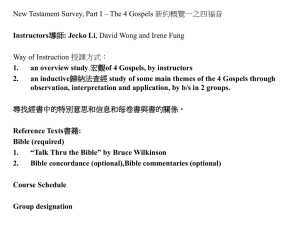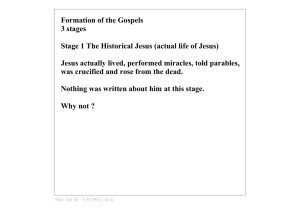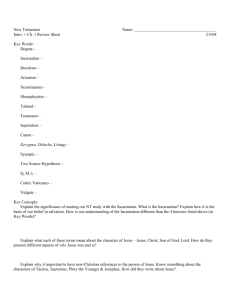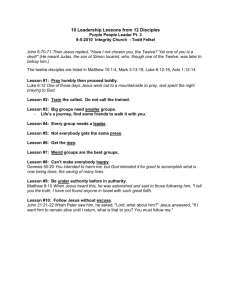The Resurrection of Jesus the Messiah
advertisement
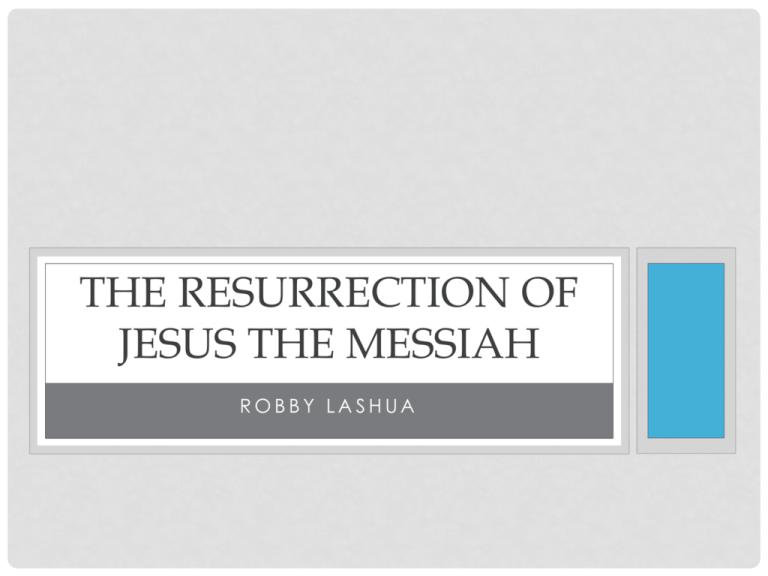
THE RESURRECTION OF JESUS THE MESSIAH ROBBY LASHUA THE RELIABILITY OF THE NEW TESTAMENT Before we begin to look into the Resurrection of Jesus Christ, we must first establish the credibility of the historical documents that give us the accounts of Jesus’ death and resurrection. THE RELIABILITY OF THE NEW TESTAMENT • Contemporary accounts, close to the events • Many accounts of the events • Independent sources • Consistent with one another Author Work Earliest MSS Time Gap Iliad History Plays Tetralogies Gallic Wars History of Rome Date Written 800 BC 480-425 BC 496-406 BC 400 BC 100-44 BC 59 BC–17 AD Homer Herodotus Sophocles Plato Caesar Livy Old # New c. 400 BC 1st C 3rd C BC 895 9th C Early 5th C 400 1,350 100-200 1,300 950 400 643 8 100 7 10 1 Partial, 19 copies 1,757 109 193 210 251 90 & 60 copies Tacitus Annals 100 AD 1st half: 850, 2nd: 1050 (1100 AD) 750-950 20 2 + 31 15 C copies Pliny, the Elder Natural History 49-79 AD 5th C frag: 1; 400 (750) Rem. 14-15th C 7 200 Thucydides History 460-400 BC 3rd C BC (AD 900) 200 (1,350) 8 96 Demosthene Speeches s 300 BC Some frags from 1 C. BC. (AD 1100) 1,100+ (1,400) 200 340 NT 50-100 AD AD 130 40 5366 5,795 Author Work Earliest MSS Time Gap Iliad History Plays Tetralogies Gallic Wars History of Rome Date Written 800 BC 480-425 BC 496-406 BC 400 BC 100-44 BC 59 BC–17 AD Homer Herodotus Sophocles Plato Caesar Livy Old # New c. 400 BC 1st C 3rd C BC 895 9th C Early 5th C 400 1,350 100-200 1,300 950 400 643 8 100 7 10 1 Partial, 19 copies 1,757 109 193 210 251 90 & 60 copies Tacitus Annals 100 AD 1st half: 850, 2nd: 1050 (1100 AD) 750-950 20 2 + 31 15 C copies Pliny, the Elder Natural History 49-79 AD 5th C frag: 1; 400 (750) Rem. 14-15th C 7 200 Thucydides History 460-400 BC 3rd C BC (AD 900) 200 (1,350) 8 96 Demosthene Speeches s 300 BC Some frags from 1 C. BC. (AD 1100) 1,100+ (1,400) 200 340 NT 50-100 AD AD 130 40 5366 5,795 Author Work Earliest MSS Time Gap Iliad History Plays Tetralogies Gallic Wars History of Rome Date Written 800 BC 480-425 BC 496-406 BC 400 BC 100-44 BC 59 BC–17 AD Homer Herodotus Sophocles Plato Caesar Livy Old # New c. 400 BC 1st C 3rd C BC 895 9th C Early 5th C 400 1,350 100-200 1,300 950 400 643 8 100 7 10 1 Partial, 19 copies 1,757 109 193 210 251 90 & 60 copies Tacitus Annals 100 AD 1st half: 850, 2nd: 1050 (1100 AD) 750-950 20 2 + 31 15 C copies Pliny, the Elder Natural History 49-79 AD 5th C frag: 1; 400 (750) Rem. 14-15th C 7 200 Thucydides History 460-400 BC 3rd C BC (AD 900) 200 (1,350) 8 96 Demosthene Speeches s 300 BC Some frags from 1 C. BC. (AD 1100) 1,100+ (1,400) 200 340 NT 50-100 AD AD 130 40 5366 5,795 Author Work Earliest MSS Time Gap Iliad History Plays Tetralogies Gallic Wars History of Rome Date Written 800 BC 480-425 BC 496-406 BC 400 BC 100-44 BC 59 BC–17 AD Homer Herodotus Sophocles Plato Caesar Livy Old # New c. 400 BC 1st C 3rd C BC 895 9th C Early 5th C 400 1,350 100-200 1,300 950 400 643 8 100 7 10 1 Partial, 19 copies 1,757 109 193 210 251 90 & 60 copies Tacitus Annals 100 AD 1st half: 850, 2nd: 1050 (1100 AD) 750-950 20 2 + 31 15 C copies Pliny, the Elder Natural History 49-79 AD 5th C frag: 1; 400 (750) Rem. 14-15th C 7 200 Thucydides History 460-400 BC 3rd C BC (AD 900) 200 (1,350) 8 96 Demosthene Speeches s 300 BC Some frags from 1 C. BC. (AD 1100) 1,100+ (1,400) 200 340 NT 50-100 AD AD 130 40 5366 5,795 Author Work Earliest MSS Time Gap Iliad History Plays Tetralogies Gallic Wars History of Rome Date Written 800 BC 480-425 BC 496-406 BC 400 BC 100-44 BC 59 BC–17 AD Homer Herodotus Sophocles Plato Caesar Livy Old # New c. 400 BC 1st C 3rd C BC 895 9th C Early 5th C 400 1,350 100-200 1,300 950 400 643 8 100 7 10 1 Partial, 19 copies 1,757 109 193 210 251 90 & 60 copies Tacitus Annals 100 AD 1st half: 850, 2nd: 1050 (1100 AD) 750-950 20 2 + 31 15 C copies Pliny, the Elder Natural History 49-79 AD 5th C frag: 1; 400 (750) Rem. 14-15th C 7 200 Thucydides History 460-400 BC 3rd C BC (AD 900) 200 (1,350) 8 96 Demosthene Speeches s 300 BC Some frags from 1 C. BC. (AD 1100) 1,100+ (1,400) 200 340 NT 50-100 AD AD 130 40 5366 5,795 “Besides textual evidence derived from New Testament Greek manuscripts and from early versions, the textual critic has available the numerous scriptural quotations included in the commentaries, sermons, and other treatises written by the early Church fathers. Indeed, so extensive are these citations that if all other sources for our knowledge of the text of the New Testament were destroyed, they would be sufficient alone for the reconstruction of practically the entire New Testament.” -Bruce M. Metzger & Bart D. Ehrman Bruce M. Metzger and Bart D. Ehrman, The Text of the New Testament: Its Transmission, Corruption, and Restoration 4th ed., (New York: Oxford, 2005), 126. “The number of manuscripts of the New Testament, of early translations from it, and of quotations from it in the oldest writers of the Church, is so large that it is practically certain that the true reading of every doubtful passage is preserved in some one or other of these ancient authorities. This can be said of no other ancient book in the world.” -Sir Frederic Kenyon Quotations of the N.T. by early Church Fathers Author Gospels Acts Pauline Epistles General Epistles Justin Martyr 268 10 43 6 3 330 Irenaeus 1,038 194 499 23 65 1,819 Clement 1,107 44 1,127 207 11 2,406 Origin 9,231 349 7,778 399 165 17,992 Tertullian 3,822 502 2,609 120 205 7,258 Hippolytus 734 42 387 27 188 1,378 Eusebius 3,258 211 1,592 88 27 5,176 1,352 14, 035 870 664 36,289 Grand Totals 19,368 Taken from Josh McDowell, New Evidence That Demands a Verdict, p. 43 Rev. Totals NEW TESTAMENT TRUSTWORTHY “On the contrary, the 10000 time between the composition of the books 9000 of the New Testament 8000 and the earliest extant 7000 copies is relatively brief. 6000 Instead of a lapse of a millennium or more, as is 5000 the case of not a few classical authors, several 4000 3000 papyrus manuscripts of portions of the New 2000 Testament are extant that were copied within a 1000 0 century or so after the composition of the original documents.” Metzger and Ehrman Others Armenian Slavic Latin NEW TESTAMENT TRUSTWORTHY Sir Frederic Kenyon: “The number of manuscripts of the New Testament, of early translations from it, and of quotations from it in the oldest writers of the Church, is so large that it is practically certain that the true reading of every doubtful passage is preserved in some one or other of these ancient authorities. This can be said of no other ancient book in the world.” 25000 20000 15000 10000 5000 0 MSS Others Homer NT NON-CHRISTIAN SOURCES Josephus • Born around A.D. 37 • Father was a respected priest in Jerusalem named Matthias • Fought against the Romans, but was defeated by them • Joined the Romans as the court historian for Emperor Vespasian • Josephus mentions Jesus on two occasions in his writings NON-CHRISTIAN SOURCES “Having such a character, Ananus thought that with Festus dead and Albinus still on the way he would have the proper opportunity. Convening the judges of the Sanhedrin, he brought before them the brother of Jesus who was called the Christ, whose name was James, and certain others. He accused them of having transgressed the law and delivered them up to be stoned.” -Josephus Antiquities 20.200. NON-CHRISTIAN SOURCES “At this time there appeared Jesus, a wise man, if indeed one should call him a man. For he was a doer of startling deeds, a teacher of people who receive the truth with pleasure. And he gained a following both among many Jews and among many of Greek origin. He was the Messiah. And when Pilate, because of accusations made by the leading men among us, condemned him to the cross, those who had loved him previously did not cease to do so. For he appeared to them on the third day, living again, just as the divine prophets had spoken of these and countless other wondrous things about him. And up until this very day the tribe of Christians, named after him, has not died out.” – Josephus Antiquities 18.63-64. NON-CHRISTIAN SOURCES “At this time there appeared Jesus, a wise man, if indeed one should call him a man. For he was a doer of startling deeds, a teacher of people who receive the truth with pleasure. And he gained a following both among many Jews and among many of Greek origin. He was the Messiah. And when Pilate, because of accusations made by the leading men among us, condemned him to the cross, those who had loved him previously did not cease to do so. For he appeared to them on the third day, living again, just as the divine prophets had spoken of these and countless other wondrous things about him. And up until this very day the tribe of Christians, named after him, has not died out.” – Josephus Antiquities 18.63-64. NON-CHRISTIAN SOURCES Tacitus • Lived ca. A.D. 56-120 • Regarded as the greatest of Roman historians • Mentions Jesus once in Annals which was written ca. A.D. 116-117 NON-CHRISTIAN SOURCES “Therefore, to squelch the rumor, Nero created scapegoats and subjected to the most refined torture those whom the common people called ‘Christians’ (a group) hated for their abominable crimes. Their name comes from Christ, who, during the reign of Tiberius, had been executed by the procurator Pontius Pilate. Supressed for the moment, the deadly superstition broke out again, not only in Judea, the land which originated this evil, but also in the city of Rome.” – Tacitus Annals 15.44. NON-CHRISTIAN SOURCES • Within 150 years of the life of Jesus, there are 10 known non-Christian sources who mention Jesus. • Tiberius Caesar, the Roman emperor at the time of Jesus, has 9 non-Christian sources who mention him over the same 150 years • If we include Christian sources, Jesus is mentioned by 43 sources and Tiberius is mentioned by 10 sources within these 150 years NON-CHRISTIAN SOURCES These 10 non-Christian sources give us the following facts about Jesus • • • • • • • • • • • • Jesus lived during the time of Tiberius Caeser He lived a virtuous life He was a wonder-worker He had a brother named James He was acclaimed to be the Messiah He was crucified under Pontius Pilate He was crucified on the eve of the Jewish Passover Darkness and an earthquake occurred when he died His disciples believed that he rose from the dead His disciples were willing to die for their belief Christianity spread rapidly as far as Rome His disciples denied the Roman gods and worshiped Jesus as God INTERNAL EVIDENCE Bart Ehrman Video clip http://www.youtube.com/watch?v=p2w6G5i6Y0A Watch from 34:00-41:30 INTERNAL EVIDENCE Evidence that the Gospels were written within the lifetime of the Apostles: • Matthew, Mark and Luke do not name the woman who anointed Jesus feet even though she is to be remembered or the man who cut off the ear of the high priest’s servant in the garden of Gethsemane. • Why? Perhaps to protect these people who were still alive? • Embarrassing details: “Get behind me Satan”, Peter’s denials of Jesus, Jesus’ family not believing in Him. DO THE GOSPELS CONTRADICT EACH OTHER? What if they do? The Women at the Tomb • Matt. 28; Mark; 16; Luke 24:12 (Multiple Women) • John 20:1-2 (One Woman?) • Now the first day of the week Mary Magdalene went to the tomb early, while it was still dark, and saw that the stone had been taken away from the tomb. Then she ran and came to Simon Peter, and to the other disciple, whom Jesus loved, and said to them, ‘They have taken away the Lord out of the Tomb, and WE do not know where they have laid him.’”. John 20:1-2 THE GOSPELS REPORT THINGS IDEA FOR IDEA Ipsissima Verba • Latin for “The Very Words” Ipsissima Vox • Latin for “The Very Voice” • Jesus spoke Aramaic, but the Gospels were written in Greek • Jesus taught for hours, but we can read his speeches in minutes • The Gospel writers do not agree word for word THE GOSPELS REPORT THINGS IDEA FOR IDEA Ipsissima Vox • Paul’s conversion experience • Acts 9:1-21 (read 9:1-6) • Acts 22:6-15 • Acts 26:12-20 (read 26:12-14) THE GOSPELS REPORT THINGS IDEA FOR IDEA Jesus on divorce: • Mark 10:1-12 (read 11-12) • Matthew 19:1-12 (read 9) • Why was it permissible for Matthew to add the exception clause? • Maybe he knew this was Jesus’ view • Maybe Mark left this out • Maybe Jesus spoke at different times on this subject and Matthew was giving the Ipsissima Vox of Jesus’ statements on divorce. A WORD ON BIAS Were the N.T. writers biased? • Some say that the N.T. cannot be trusted because the authors were biased and trying to convert people to their beliefs • The question we should ask is why were the authors converted themselves. • Everyone who has ever written is biased. DATING OF THE GOSPELS • Mark 65-70 A.D. • Matthew and Luke after Mark but prior to 70 A.D. • John 90-95 A.D. THE TWO SOURCE HYPOTHESIS DATING OF THE GOSPELS Reasons for Markan Priority • If Mark was not first, he would have: • Taken Matthew and cut material • Use worse grammar • Add only three new additions to Matthew’s Gospel • More probable Mark was used by Matthew. DATING OF THE GOSPELS The Q Document • 235 verses that comprise what we call Q • Examples: Matt. 3:7-10 & Luke 3:7-9; Matt. 6:24 & Luke 16:13 • Arguments for Q • Luke did not know Matthew • Infancy narratives in Matt. And Luke only. They are so different, which shows Luke knew nothing of Matthew • When Matthew adds to Mark, it is rarely found in Luke. • Both Matthew and Luke preserve the more primitive version of Q at different times. MARK AND MATTHEW DIFFERENCES Mark: the Girl Version Matthew: The Guy Version • Jairus’ Daughter • Mark 5:22-24 “One of the synagogue officials named Jairus came up, and on seeing Him, fell at His feet and implored Him earnestly, saying, “My little daughter is at the point of death; please come and lay Your hands on her, so that she will get well and live.” • Matthew 9:18-19, 23-25 “While He was saying these things to them, a synagogue official came and bowed down before Him, and said, “My daughter has just died; but come and lay Your hand on her, and she will live.” Jesus got up and began to follow him, and so did His disciples”. GENRE OF THE GOSPELS? Greco-Roman Biographies Usual length 10,000-25,000 words Subject of the verb more than 20% Focused on an individual Little mention of the subjects childhood Stories, Sayings, and Speeches of the Subject • Subject’s Character is revealed • • • • • See Richard Burdge’s What are the Gospels? GENRE OF GOSPELS Theon wrote between 70-125 A.D. and gives rules for writing biography. Plutarch (46-120 A.D.) wrote many biographies, and many had parallel accounts. "So you have the same biographer telling the same story five different times. By noticing how Plutarch tells the story of Caesar's assassination differently, we can notice the kinds of biographical liberties that Plutarch took, and he's writing around the same time that some of the Gospels are being written and in the same language -- Greek -- to boot,” Michael Licona Information from Advanced Apologetics taught by Michael Licona Fall 2012 at Biola Univeristy GENRE OF GOSPELS Licona’s initial findings in Theon • Variation in Syntax • Addition • Subtraction • Substitution • Recast statement as question • Speeches may be recomposed Information from Advanced Apologetics taught by Michael Licona Fall 2012 at Biola Univeristy GENRE OF GOSPELS Six Liberties Licona found in Plutarch • Compression/Telescoping • Conflation • Displacement • Transferal • Create Narrative Details • Creative Narrative Context Information from Advanced Apologetics taught by Michael Licona Fall 2012 at Biola Univeristy PAUL’S EPISTLES “The seven letters that virtually all scholars agree Paul wrote—the socalled undisputed Pauline epistles—are Romans, 1 and 2 Corinthians, Galatians, Philippians, 1 Thessalonians, and Philemon.” - Bart Ehrman PAUL’S EPISTLES Ehrman’s argument: • Greco-Roman letters were very short and to the point • Cicero: Avg 295 words (range 22-2,530) • Seneca: Avg 995 words (range 149-4,134) • Paul’s UNDISPUTED letters: Avg. 3,442 • Rom. 7,111; 1 Cor. 6,830; 2 Cor. 4,477; Phil. 1,629; 1 Thess. 1,481; Philemon 335 • Paul’s disputed letters Avg. 1,386 • Eph. 2,422; Col. 1,582; 2 Thess. 823; 1 Tim. 1,591; 2 Tim. 1,238; Titus 659 PAUL’S EPISTLES Ehrman’s argument: • There is no evidence Paul extensively used a secretary to write his letters. • “Virtually all of the problems with what I have been calling forgeries can be solved if secretaries were heavily involved in the composition of the early Christian writings.” –Bart Ehrman in Forged PAUL’S EPISTLES Good reasons for thinking Paul used secretaries • Poor Speaker • 2 Cor. 11:6 “Untrained in Public speaking” • 2 Cor. 10:9-11 “for I do not wish to seem as if I would terrify you by my letters. For they say, “His letters are weighty and strong, but his personal presence is unimpressive and his speech contemptible.” Let such a person consider this, that what we are in word by letters when absent, such persons we are also in deed when present.” PAUL’S EPISTLES Good reasons for thinking Paul used secretaries • Rom. 16:22 “I, Tertius, who write this letter, greet you in the Lord.” • 1 Cor. 16:21 “This greeting is in my own hand” • Philemon 19 “I, Paul, am writing this with my own hand, I will repay it.” • These are all from the UNDISPUTED letters of Paul. PAUL’S EPISTLES Licona on Paul’s use of secretaries http://www.youtube.com/watch_popup?v=poiDolq0Y to Licona on how many letters Paul wrote http://www.youtube.com/watch_popup?v=cxBnrveV piM


